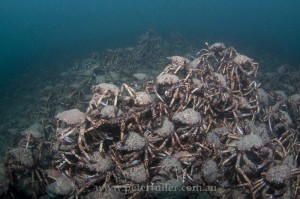Dive Number: 315 10/06/12 14.20, Rye Pier
Wind: ???
Tide: ???
Conditions:
Visibilty: 8m
Water Temp: 12.2c
Bottom Time: 76minutes
Max Depth: 5.4m
Air usage:
SAC: ???? litres/min
Details: I made my second visit to the spidercrabs and it was a vastly different experience to the first and really put the puzzle peices together.
My first visit was when the aggregation was at its peak. Of the 10’s of thousands of spidercrabs present that day, i only spotted a few of decent size. The majority were small with a dark brown body, and these were the spidercrabs forming stacks on top of each other. Most spidercrabs on this day were fairly inactive and almost appeared to be resting or sleeping.
On my visit yesterday, numbers had decreased significantly, there were still some of these small, brown shelled crabs around, but the majority where large red/orange shelled crabs. These large crabs were very active, “marching” en-masse within the L-shaped confines of the pier with some climbing up the pylons and over the thousands of “brown-shelled” carapace’s littering the area under the pier.
It all started making sense when i saw one of these small-brown spider crabs actually going through the moulting process and seeing a newly formed red-shelled ‘adult’ spider crab about to emerge from the rear of the brown-shell.
It dawned on me that the intial aggregation were all pre-moult crabs that had come together to provide a ‘safety in numbers’ approach to sheding their old shell and emerging as a new ‘adult’ spidercrab. This process involved a period on non-activity where they were rendered immobile as they formed a new shell within the confines of thier old one, and then had to emerge from their old shell in a gelatenous, soft shelled form. All this makes an individual vunerable to predation, however, as a spider crab undergoing this process, you’re much safer if you can perfrom this process in the bottom layer of a stacked mass of spider crabs. The species as a whole has a much better chance of continuation if they can at least get a few thousand individuals safely through the moult process and into a hardened adult form. Of course, the crabs probably dont have such altruistic goals. Each individual wants to be in the centre of the bottom layer of the stack. In fact, its not the bottom layer of the stack that is the ultimate position, its the centre of the group…e.g. not on the outside flanks. This leads to stacking because all the crabs are climbing over each other trying to get into the centre. (or a positon that is away from the outside edges of the group.)
All the above is well documented and has been said before(and i’ve probably got some assumptions and terminolgies wrong), but to see these two distinct periods of the same event with my own eyes, has really made it all the more amazing, so i’d thought i’d share my experience.
Camera Details: Tokina 10-17mm , SS200 Strobes
Photos:



















































































































